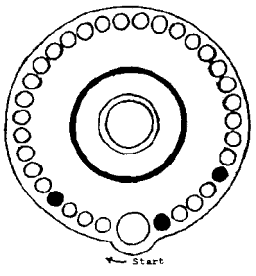 |
Science Frontiers ONLINE No. 36: Nov-Dec 1984 |
|
|
The Mallia Table
The Mallia Table was discovered in the Central Court of the Minoan Palace of Mallia on Crete. It is a large limestone disk 90 centimeters in diameter and 36 centimeters thick. Around its circumference are 33 cups of equal size. A 34th. cup is larger and is located in a sort of ear that extends beyond the normal circumference of the disk. The larger cup is oriented due south. The disk is set in the stone pavement of a small terrace that is slightly elevated above the level of the Central Court. This strange monolith, which dates circa 1,900-1,750 BC, has been a puzzle to scholars since its discovery in 1926 by French excavators.
C.F. Herberger's thesis is that the disk is a lunisolar clock. The 33 small cups provide a convenient and symmetrical division of the 99 lunations of the 8-year cycle. By moving markers, one could have a fairly accurate lunisolar clock. The 34th. cup, by virtue of its larger size, would announce the need for an intercalcated month. This sort of clock, even though arrived at empirically, represents a remarkable innovation for a period almost 4,000 years ago.
(Herberger, Charles F.; "The Mallia Table: Kernos or Clock?" Archaeoastronomy, 6:114, 1983.)
 | Diagram of the Mallia disk, with intercalation cups in black. Diameter: about 3 ft. |